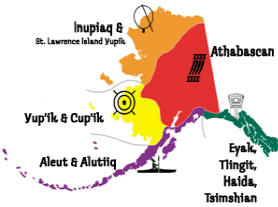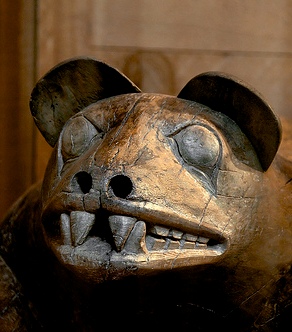|
Alaska Natives are the indigenous peoples of Alaska. They include: Aleut, Inuit, Tlingit, Haida, Tsimshian, Eyak, and a number of Northern Athabasca cultures. Alaskan natives in Alaska number about 119,241 (as of the 2000 census). There are 229 federally recognized Alaskan villages and five unrecognized Tlingit Alaskan Indian tribes.
The Tsimshian have a complex social system consisting of phratries and clans. Phratries are similar to moieties, except they have four divisions instead of two. There are four crests: Killerwhale (Blackfish), Wolf, Raven and Eagle. However Fireweed, Wolf, Raven and Eagle are the Gitksan’s phratry names. The Tsimshian Killerwhale and Wolf are one side and their opposite side are the Eagle and Raven. However, the Gitksan have Fireweed and Wolf as their opposites to Eagle and Raven.
Like the Eyak, Tlingit and Haida, they have an exogamous matrilineal clan system. The Tsimshian people speak another isolate language, Sm’algyax, which has four main dialects: Coast Tsimshian, Southern Tsimshian, Nisga’a, and Gitksan. Society was also divided by high-ranking individuals/families, commoners and slaves. Unlike present day marriages, weddings were arranged by family members. Slaves were usually captives from war raids on other villages. Community status could be elevated by hosting a potlatch.
The original homeland of the Tsimshian is between the Nass and Skeena Rivers in British Columbia, Canada, though at contact in Southeast Alaska’s Portland Canal area, there were villages at Hyder and Halibut Bay. Presently in Alaska, the Tsimshian live mainly on Annette Island, in (New) Metlakatla, Alaska in addition to settlements in Canada.
Like all Northwest Coastal peoples, they thrived on the abundant sea life, especially salmon. The Tsimshian were a seafaring people, like the Haida. A staple for many years, the salmon continues to be at the center of their nutrition, despite large-scale commercial fishing. This abundant food source enabled the Tsimshian to live in permanent towns.
The Tsimshian lived in large longhouses, made from cedar house posts and panels. These were very large, and usually housed an entire extended family. Cultural taboos related to prohibiting women and men eating improper foods during and after childbirth. The marriage ceremony was an extremely formal affair, involving several prolonged and sequential ceremonies.Tsimshian religion centered around the "Lord of Heaven", who aided people in times of need by sending supernatural servants to earth to aid them. The Tsimshian believed that charity and purification of the body (either by cleanliness or fasting) was the route to the afterlife.
The Tsimshian engage in the potlatch, which they refer to as the yaawk, or feast. Today in Tsimshian culture, the potlatch is held at gatherings to honor deaths, burials, and succession to name-titles.The Tsimshian live on in their art, their culture and their language, which is making a comeback. Like other coastal peoples, the Tsimshian fashioned most of their goods out of Western red cedar, particularly from its bark. It could be fashioned into tools, clothing, roofing, armor, building materials and canoe skins. They used cedar in their Chilkat weaving, which they are credited with inventing.
The Tsimshian competed with the Tlingit, Haida, the Athapaskan groups in the north, the Dunne-Za in the east, and the Kwakiutl groups in the south.
The Tsimshian speak a Tsimshianic language, referred to by linguists as "Coast Tsimshian" and by Tsimshians as Sm'algyax, which means "real or true tongue." It has differing dialects from the North in Taquan to the south in Klemtu. Tsimshian also speak the same language as the Gitxsan and the Nisga’a, yet the dialect is further differentiated than the regional Tsimshian variations. Very few speakers remain today in Canada and Alaska. Some linguists classify Tsimshianic languages as a member of the theoretical Penutian language group.
Raven is the culture hero of the Tsimshian and other Northwest Coast tribes. He is a revered and benevolent transformer figure who helps the people and shapes their world for them, but at the same time, he is also a trickster character and many Raven stories have to do with his frivolous or poorly thought out behavior getting him into trouble. Txaamsm is the hero's personal name and is pronounced
similar to chahm-sum (sometimes also spelled Txa'msem, Txamsem, Txamsen, Chemsem, or other ways) Wigyet is pronounced similar to weeg-yet (sometimes also spelled Wiigyet, Wegyet, or We-gyet) and is an eponym meaning "big man" or "giant." Occasionally he may also be referred to by the name Gaax (pronounced similar to gawkh), which is the literal Tsimshian word for "raven."
|




